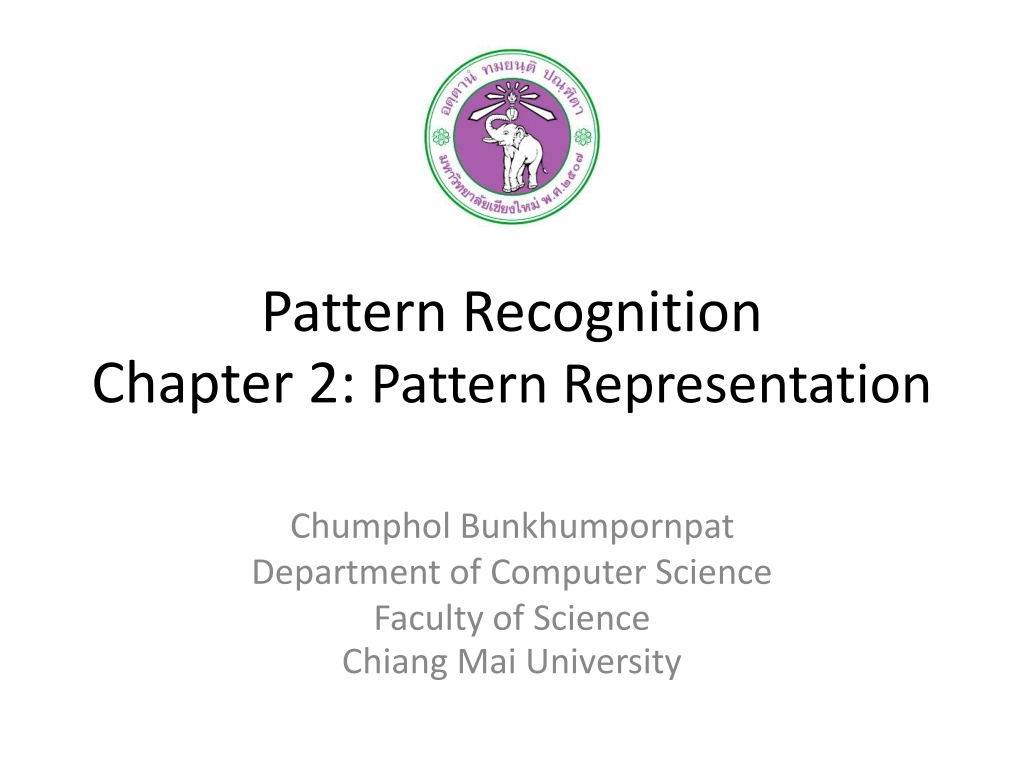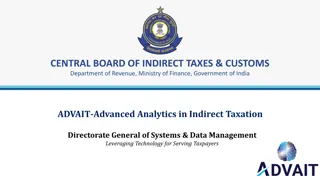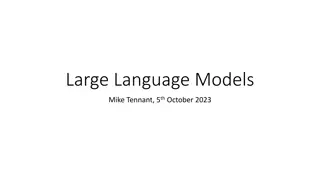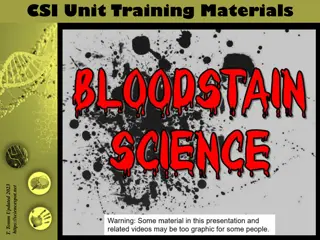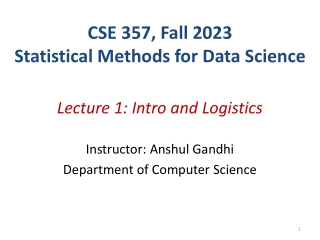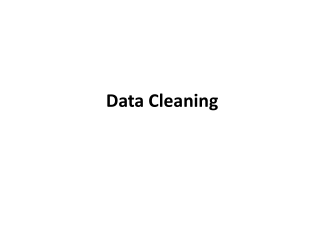Understanding Pattern Recognition in Data Science
Explore the concept of pattern recognition through chapters on pattern representation, learning objectives, KDD process, and classification. Dive into the Iris dataset and learn how patterns are represented and classified based on their attributes.
Download Presentation
Please find below an Image/Link to download the presentation.
The content on the website is provided AS IS for your information and personal use only. It may not be sold, licensed, or shared on other websites without obtaining consent from the author. Download presentation by click this link. If you encounter any issues during the download, it is possible that the publisher has removed the file from their server.
Presentation Transcript
Pattern Recognition Chapter 2: Pattern Representation Chumphol Bunkhumpornpat Department of Computer Science Faculty of Science Chiang Mai University
Learning Objectives KDD Process Know that patterns can be represented as Vectors Strings Logical descriptions Fuzzy sets 2 204453: Pattern Recognition
Learning Objectives (cont.) Have found out what is involved in abstract of data Know the parameters involved in evaluation of classifiers 3 204453: Pattern Recognition
Learning Objectives (cont.) Have found out what is involved in abstract of data Know the parameters involved in evaluation of classifiers 4 204453: Pattern Recognition
KDD (Knowledge Discovery in Databases) Process 5 204453: Pattern Recognition
Representation Pattern Physical Object Abstract Notion Pattern: A Set of Descriptions Animal: ? Ball: Size, Material 6 204453: Pattern Recognition
Pattern is the representation of an object by the values taken by the attributes (features) 7 204453: Pattern Recognition
8 204453: Pattern Recognition
Classification A dataset has a set of classes, and each object belongs to one of these classes. Animals (Pattern): Mammals, Reptiles (Classes) Balls (Pattern): Football, Table Tennis Ball (Classes) Common technique that separates patterns into different classes. 9 204453: Pattern Recognition
Iris Dataset 10 204453: Pattern Recognition
Patterns as Vectors An Obvious Representation of a Pattern Each element of the vector can represent one attribute of the pattern. 12 204453: Pattern Recognition
Spherical Objects (30, 1): 30 units of weight and 1 unit diameter (30, 1, 1): The last element represents the class of the objet (spherical objects). 13 204453: Pattern Recognition
Example 1 1.0, 1.0, 1 ; 2.0, 1.0, 1 ; 4.0, 1.0, 2 ; 4.0, 2.0, 2 ; 1.0, 4.0, 2 ; 2.0, 4.0, 2 ; 4.0, 4.0, 1 ; 4.0, 5.0, 1 ; 1.0, 2.0, 1 2.0, 2.0, 1 5.0, 1.0, 2 5.0, 2.0, 2 1.0, 5.0, 2 2.0, 5.0, 2 5.0, 5.0, 1 5.0, 4.0, 1 14 204453: Pattern Recognition
Example Data Set: The Square Represents a Test Pattern 15 204453: Pattern Recognition
Patterns as Strings A gene can be defined as a region of the chromosomal DNA constructed with four nitrogenous bases: Adenine: A Guanine : G Cytosine: C Thymine: T GAAGTCCAG 16 204453: Pattern Recognition
17 204453: Pattern Recognition
Logical Descriptions x1and x2: The attributes of the pattern aiand bi: The values taken by the attribute A Conjunction of Logical Disjunctions (x1= a1..a2) (x2= b1..b2) Cricket Ball (colour = red white) (make = leather) (shape = sphere) 18 204453: Pattern Recognition
19 204453: Pattern Recognition
Fuzzy Sets Fuzziness is used where it is not possible to make precise statements. X = (small, large) X = (?, 6.2, 7) The objects belong to the set depending on a membership value which varies from 0 to 1. X = ([0,1], 6.2, 7) 20 204453: Pattern Recognition
Distance Measure Find the dissimilarity between pattern representations Patterns which are more similar should be closer. 23 204453: Pattern Recognition
Distance Function Metric Non-Metric 24 204453: Pattern Recognition
Metric Positive Reflexivity: d(x, x) = 0 Symmetry: d(x, y) = d(y, x) Triangular Inequality: d(x, y) d(x, z) + d(z, y) 25 204453: Pattern Recognition
Minkowski Metric 26 204453: Pattern Recognition
Euclidean Distance (L2; m = 2) d2(x, y) = (x1 y1)2+ (x2 y2)2+ + (xd yd)2 27 204453: Pattern Recognition
X = (4, 1, 3); Y = (2, 5, 1) d(X, Y) = (4 2)2+ (1 5)2+ (3 1)2= 4.9 29 204453: Pattern Recognition
Distance Measure (cont.) It should be ensure that all the features have the same range of values, failing which attributes with larger ranges will be treated as more important. To ensure that all features are in the same range, normalisation of the feature values has to be carried out. 32 204453: Pattern Recognition
Example of Data X1: (2, 120) X2: (8, 533) X3: (1, 987) X4: (15, 1121) X5: (18, 1023) 33 204453: Pattern Recognition
Example of Data (Cont.) It gives the equal importance to every feature. If the 2ndfeature (much larger) is used for computing distances, the 1stfeature will be insignificant and will not have any bearing on the classification. 34 204453: Pattern Recognition
Normalisation of Data It divides every value of the feature by its maximum value. All the values will lie between 0 and 1. 35 204453: Pattern Recognition
Normalisation of Data (cont.) X1: (2, 120) X2: (8, 533) X3: (1, 987) X4: (15, 1121) X5: (18, 1023) X 1: (0.11, 0.11) X 2: (0.44, 0.48) X 3: (0.06, 0.88) X 4: (0.83, 1.0) X 5: (1.0, 0.91) MAX : 18, 1121 36 204453: Pattern Recognition
Weighted Distance Measure When attributes need to treated as more important, a weight can be added to their values. wkis the weight associated with the kthdimension (or feature). 37 204453: Pattern Recognition
Weighted Distance Measure (cont.) 38 204453: Pattern Recognition
X = (4, 2, 3); Y = (2, 5, 1) w1= 0.3; w2= 0.6; w3= 0.1 d(X, Y) = 0.3 (4 2)2+ 0.6 (1 5)2+ 0.1 (3 1)2 = 3.35 39 204453: Pattern Recognition
Example of Data (Cont.) X1: (2, 120) X2: (8, 533) X3: (1, 987) X4: (15, 1121) X5: (18, 1023) w1= ? ; w2= ? 40 204453: Pattern Recognition
Non-Metric Similarity Functions They do not obey either the triangular inequality or symmetry come under this category. They are useful for images or string data. They are robust to outliers or to extremely noisy data. 41 204453: Pattern Recognition
Non-Metric Similarity Functions (cont.) k-Median Distance Mutual Neighbourhood Distance 42 204453: Pattern Recognition
k-Median Distance k-median operator returns the kthvalue of the ordered difference vector. X = (x1, x2, , xn) and Y = (y1, y2, , yn) d(X, Y) = k-median{sort(|x1 y1|, , |xn yn|)} 43 204453: Pattern Recognition
X = (50, 3, 100, 29, 62, 140); Y = (55, 15, 80, 50, 70, 170) Difference Vector = {5, 12, 20, 21, 8, 30} d(X, Y) = k-median {5, 8, 12, 20, 21, 30} If k = 3, then d(X, Y) = 12 44 204453: Pattern Recognition
Mutual Neighbourhood Distance For each data point All other data points are numbered from 1 to N 1 in increasing order of some distance measure. The nearest neighbour is assigned value 1. Te farthest point is assigned the value N 1. 45 204453: Pattern Recognition
Mutual Neighbourhood Distance (cont.) MND(u, v) = NN(u, v) + NN(v, u) NN(u, v): The number of data point v w.r.t. u. NN(u, u) = 0 Symmetric Reflexive Not Triangular Inequality 46 204453: Pattern Recognition
Ranking of A, B and C MND(A, B) = 2 MND(B, C) = 3 MND(A, C) = 4 1 B A B 2 C C A A B C 47 204453: Pattern Recognition
Ranking of A, B, C, D, E and F MND(A, B) = 5 MND(B, C) = 3 MND(A, C) = 7 1 D A B 2 E C A 3 F D D 4 B E E 5 C F F A B C 48 204453: Pattern Recognition
Abstractions of the Data Set A set of training patterns where the class label for each pattern is given, is used for classification. The complete training set may not be used because the processing time may be too long but an abstraction of the training set can be used. 49 204453: Pattern Recognition
Abstractions of the Data Set (cont.) No Abstraction of Patterns Single Representative per Class Multiple Representative per Class 50 204453: Pattern Recognition
